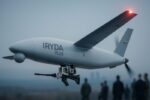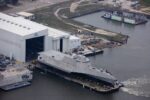In a move that underscores China’s growing investment in autonomous undersea warfare capabilities, satellite imagery and defense intelligence confirm that two extra-large uncrewed underwater vehicles (XLUUVs) have been deployed to Hainan Island for operations in the contested South China Sea. These platforms represent a significant leap in Beijing’s undersea warfare posture—combining size, range, and autonomy in a region marked by rising tensions and strategic competition.
Deployment Confirmed via Satellite Imagery
According to Naval News and corroborated by open-source intelligence analysts such as HI Sutton (@CovertShores), commercial satellite imagery from Planet Labs dated September 2025 reveals two distinctively large uncrewed underwater vehicles docked at Sanya Naval Base on Hainan Island. The vessels are moored alongside facilities used by the People’s Liberation Army Navy (PLAN) submarine force.
The XLUUVs appear to be approximately 18–20 meters long with a beam of around 2 meters—placing them in the same size category as Boeing’s Orca XLUUV or Russia’s Poseidon platform. Their hull form suggests a torpedo-like design optimized for endurance rather than speed. Notably absent are any visible sail structures or periscopes typically associated with manned submarines.
This marks the first confirmed forward deployment of Chinese XLUUVs into an operational theater. While Chinese academic literature has discussed such systems for over a decade—and prototypes have appeared at events like Zhuhai Airshow—their transition into active military use signals a new phase of capability maturation.
Design Origins and Technical Characteristics
While no official designation has been released by Chinese authorities, analysts believe these platforms may be part of the “HSU-001” family or its successors. The original HSU-001 was unveiled during China’s 2019 National Day parade but was significantly smaller (~7m). The new vessels are more than twice that length and feature redesigned hull geometries consistent with ocean-crossing endurance.
Key inferred characteristics include:
- Length: ~18–20 meters
- Displacement: Estimated >40 tons
- Propulsion: Likely lithium-ion battery powered; possible air-independent propulsion (AIP) variant under development
- Sensors: Passive sonar arrays; possibly synthetic aperture sonar (SAS); EO/IR mast optional via retractable module
- Cargo Bay: Modular payload bay capable of ISR sensors or mines
- C2 Links: Autonomous operation with intermittent satellite comms; potential use of BeiDou GNSS spoofing resistance
Their modularity suggests multi-mission roles—from persistent intelligence-surveillance-reconnaissance (ISR) patrols to seabed warfare tasks such as cable tapping or mine deployment.
A Strategic Tool for Undersea Denial and ISR
The deployment of these XLUUVs aligns with China’s broader anti-access/area denial (A2/AD) strategy in the South China Sea. By leveraging autonomous platforms capable of long-duration submerged operations without human risk or signature exposure, Beijing enhances its ability to monitor adversary naval movements across key chokepoints like the Luzon Strait and Malacca Strait approaches.
This is particularly relevant given increasing U.S. Navy freedom-of-navigation operations (FONOPs), allied submarine patrols from Australia and Japan, and Taiwan Strait tensions. Unlike manned submarines—which require significant logistical support—the XLUUVs can loiter undetected for weeks or months at depth while relaying limited data bursts via secure low-probability-of-intercept (LPI) links.
Their presence also complicates adversary ASW planning. Unlike traditional diesel-electric submarines which emit acoustic signatures during snorkeling phases, battery-powered UUVs can remain acoustically silent for extended periods—posing detection challenges even for advanced sonar arrays.
An Emerging Arms Race in Underwater Autonomy
The Chinese deployment follows similar efforts by other major naval powers:
- United States: Boeing’s Orca XLUUV program is undergoing sea trials with the U.S. Navy under a $274 million contract awarded in 2019. Orca is designed for mine-laying and ISR missions with modular payload bays.
- Russia: The Poseidon nuclear-powered autonomous torpedo is reportedly undergoing testing aboard modified Belgorod-class submarines. Its role appears more strategic/nuclear deterrent-focused than tactical ISR.
- UK & Australia: BAE Systems is developing an extra-large autonomous test vehicle under Project CETUS; Australia’s Ghost Shark program aims to field large AUV prototypes by mid-2020s through Anduril partnership.
This convergence reflects a shift toward unmanned dominance below the surface—a domain traditionally dominated by costly manned SSNs/SSKs requiring extensive training pipelines and maintenance infrastructure.
Tactical Implications and Future Outlook
The introduction of Chinese XLUUVs into contested waters raises several operational questions:
- Cueing & Targeting: How will these platforms coordinate with PLAN surface ships or satellites for real-time targeting?
- Crisis Stability Risks: Could misidentification lead to inadvertent escalation if an adversary engages what it believes is a manned submarine?
- MCM Threat Vector: If equipped for mine-laying missions near disputed reefs or straits, these UUVs could present asymmetric threats difficult to counter without extensive MCM assets.
Their emergence also underscores growing reliance on artificial intelligence (AI)-driven autonomy in maritime warfare—a trend that raises ethical concerns about decision-making latency during kinetic engagements involving unmanned systems operating beyond line-of-sight control.
A New Era Below the Waves?
The forward deployment of China’s XXL uncrewed submarines marks not just a technological milestone but also an inflection point in regional undersea dynamics. As nations invest heavily in underwater robotics—ranging from seabed sensors to armed AUV swarms—the opaque nature of subsurface competition will likely intensify geopolitical friction across Indo-Pacific flashpoints.
If current trends continue—with increasing autonomy levels paired with AI-driven navigation and mission execution—the future undersea battlespace may be dominated not by silent service crews but by algorithmically guided machines patrolling contested depths on behalf of rival states.









